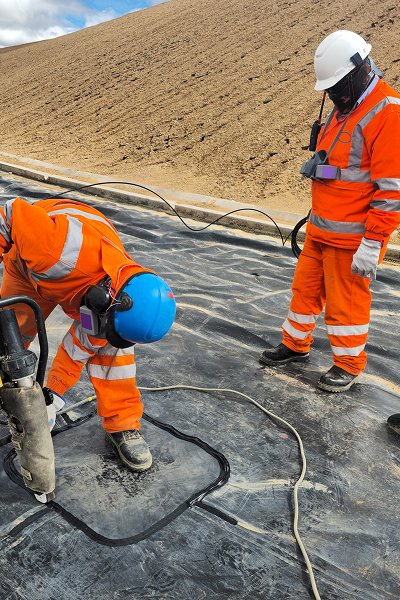The main functions of geogrid
1.Enhance soil structure stability
Core function: Improve overall bearing capacity and enhance stability
Geogrid generates bite force with filler through its grid structure, improving soil shear strength and friction resistance;
It can effectively prevent deformation, displacement or slippage of the structure after being stressed, and maintain long-term stability;
In slope engineering, it can effectively prevent landslides and collapses.
2.Reinforcement and reinforcement
Core function: Improve weak foundation and increase bearing capacity
Geogrid has significant reinforcement effect and is suitable for soft foundation treatment, which can evenly disperse external loads;
Reduce uneven settlement and total settlement, which is beneficial to the stability of subsequent pavement structure;
Applied to key parts such as embankments, dams, and bridgehead jump sections to prevent structural cracking.
3.Disperse load and transfer stress
Core function: reduce local stress concentration and improve load diffusion capacity
Geogrid converts point load into surface load and transfers it evenly to the lower layer;
Effectively reduce the damage to the roadbed or cushion caused by concentrated load;
Especially critical in heavy traffic roads or airport runways.
4.Prevent structural damage and deformation
Core function: constrain particle displacement and enhance structural rigidity
Geogrids limit the lateral movement of fillers to form a "reinforced soil" complex;
Reduce road subsidence, cracking, potholes and other problems caused by long-term use;
It can play a role in tensile reinforcement and slip restriction on the back of slopes and retaining walls.
5.Anti-scouring and isolation function
Core function: Extend the service life of the structure
In water conservancy projects, river bank protection, and slope protection, prevent water from scouring the structure;
Prevent the mixing of upper and lower layer materials, and play an effective isolation role;
Combined with non-woven fabrics and other materials, it can improve the overall anti-erosion ability.
6.Improve drainage performance (used in conjunction with other materials)
Core role: synergize drainage structure to keep the foundation dry
Combined with geotextiles, drainage nets and other materials, it can form a drainage channel;
Reduce groundwater pressure and capillary water rise, especially effective for soft soil treatment;
Helps keep the road base dry and improve road durability.
How does geogrid help build a “sponge city”?
1.Enhance the stability of permeable pavement structure
In sponge cities, permeable bricks, permeable concrete and other surface materials are widely used, and their lower structures need to have good load-bearing and drainage performance.
Geogrids are placed between the gravel base layers to effectively restrict the lateral movement of aggregates and enhance the overall strength of the structure;
Prevent the road surface from sinking, cracking or partial collapse under long-term erosion by rainwater;
Extend the service life of permeable pavement and improve road safety and comfort.
2.Improve drainage and infiltration efficiency
Geogrids can be combined with non-woven geotextiles and drainage nets to form a composite "drainage-reinforcement" system;
Enhance the rainwater guidance and dispersion function of the structural layer and promote rapid infiltration;
Prevent surface runoff concentration while reducing the burden on the downstream drainage system.
3.Assisting rainwater regulation and groundwater recharge
Geogrids support the base structure to keep the seepage pores from being compacted;
Providing good porosity is conducive to the storage and slow infiltration of rainwater in underground space;
Effectively replenishing groundwater resources, restoring the urban hydrological cycle, and strengthening the "seepage, retention, storage, and purification" system functions.
4.Green infrastructure construction
In the base of rain gardens, grass-planted ditches, ecological wetlands and other facilities, geogrids can stabilize the planting layer structure;
Prevent plant roots from sinking and enhance soil shear resistance;
At the same time, it can enhance the anti-scouring and anti-collapse performance of ecological boundaries such as slopes and revetments to ensure the long-term stable operation of green facilities.
5.Reducing the risk of urban waterlogging
In the "storage and drainage" system of sponge cities, geogrids can improve the load and drainage performance of permeable pavements or squares;
In conjunction with the infiltration and drainage pipe system, it can quickly divert heavy rainfall water flow and effectively reduce waterlogging pressure;




Comparison of Different Types of Geogrids in Permeable Pavement Applications
| Type of Geogrid | Key Characteristics | Typical Applications in Permeable Pavements |
|---|---|---|
| Uniaxial Geogrid | High tensile strength in one direction (usually longitudinal); strong soil reinforcement | Used in retaining walls, embankments, and areas requiring one-directional support |
| Biaxial Geogrid | Balanced tensile strength in both directions; good load distribution | Widely used in permeable road bases, sidewalks, and low-speed access roads |
| Triaxial Geogrid | Triangular aperture pattern; multidirectional load dispersion | Ideal for parking lots, traffic circles, and pedestrian pavements with complex loads |
| Fiberglass Geogrid | High modulus, heat resistance, and low creep | Suitable for permeable asphalt roads to reduce cracking and improve lifespan |
| Steel-Plastic Composite Geogrid | Excellent load-bearing and anti-corrosion properties | Best for heavy-load permeable pavements, such as bus stations or logistics centers |
| Polyester Woven Geogrid | Flexible, strong bonding with granular materials; resistant to elongation | Used under permeable interlocking pavers or in areas with irregular subgrades |


